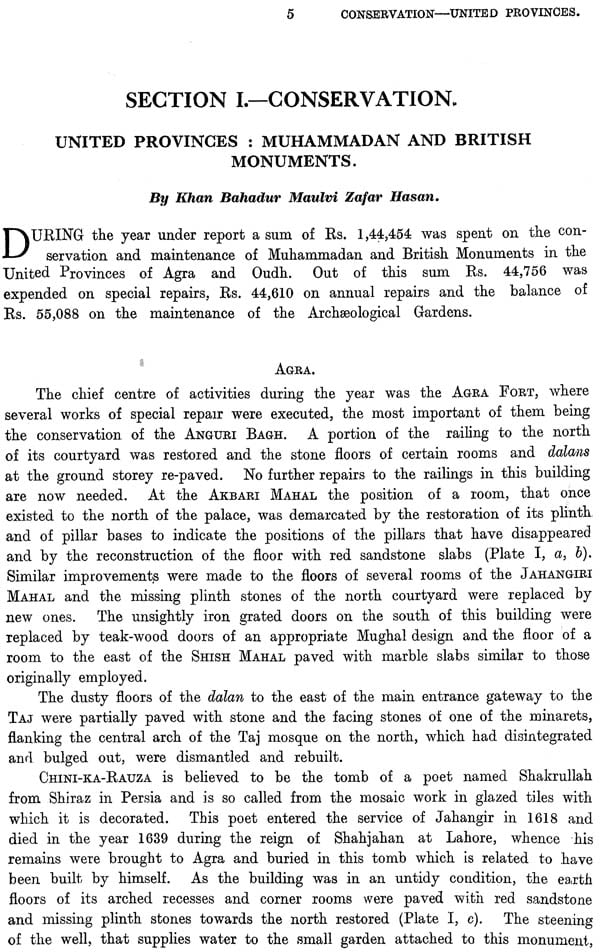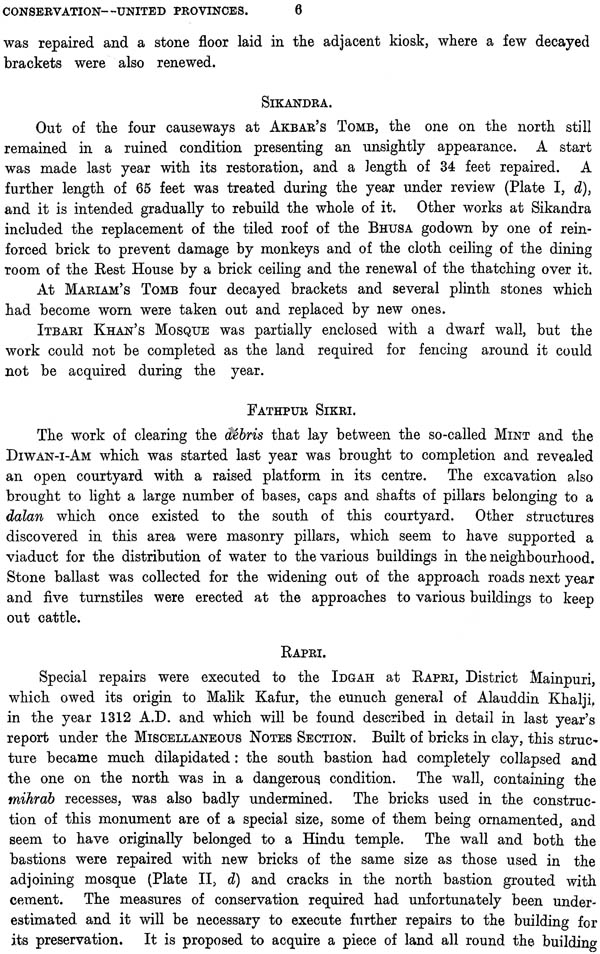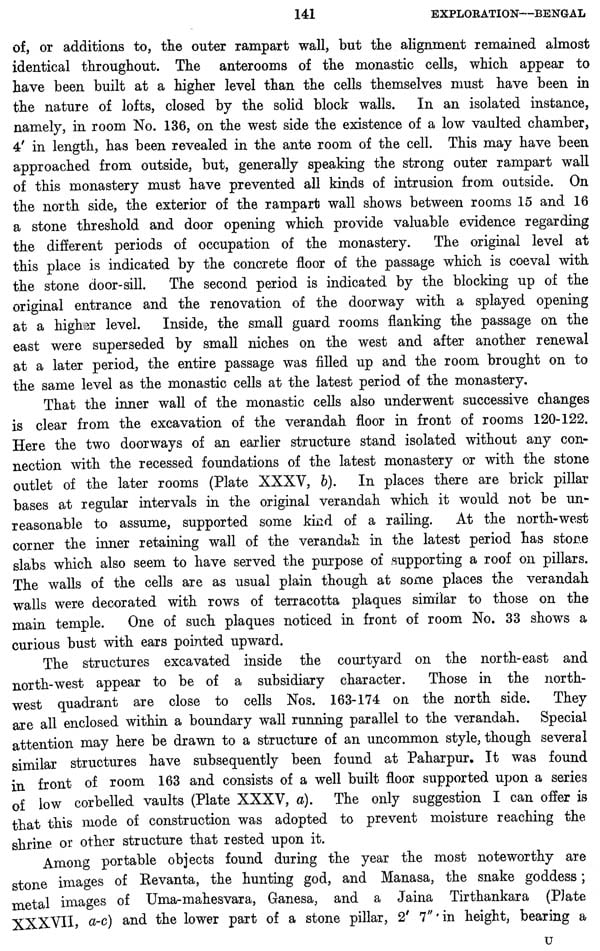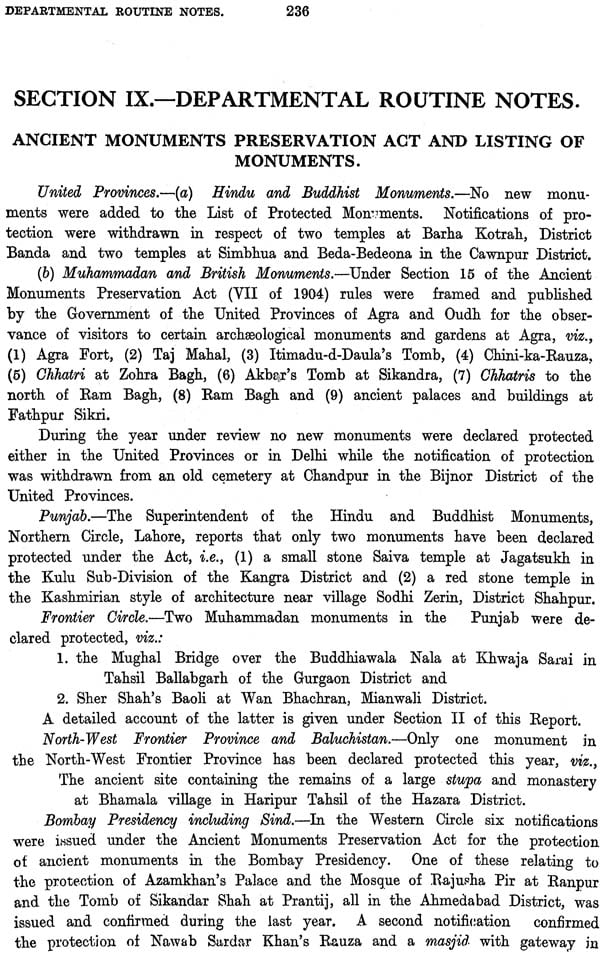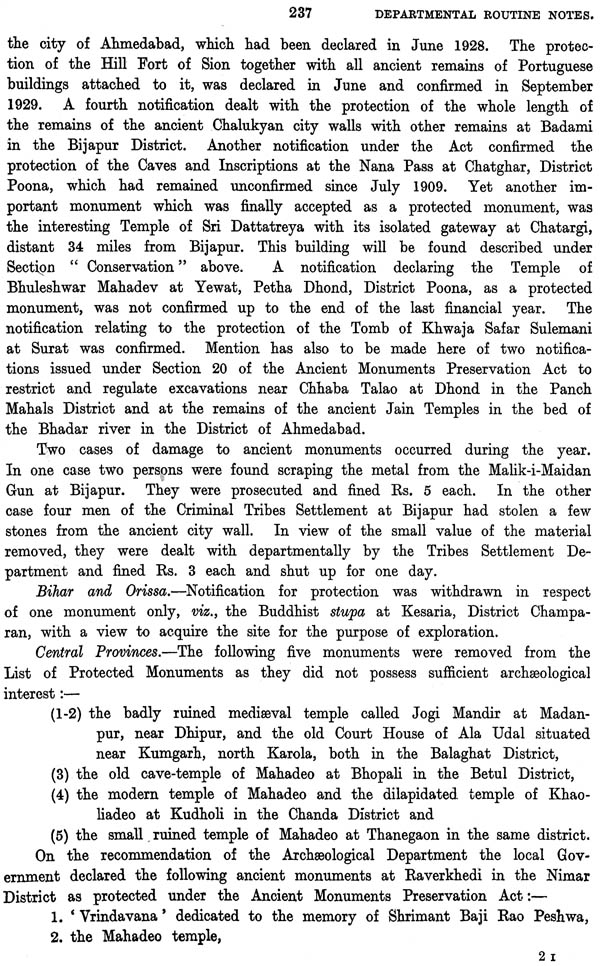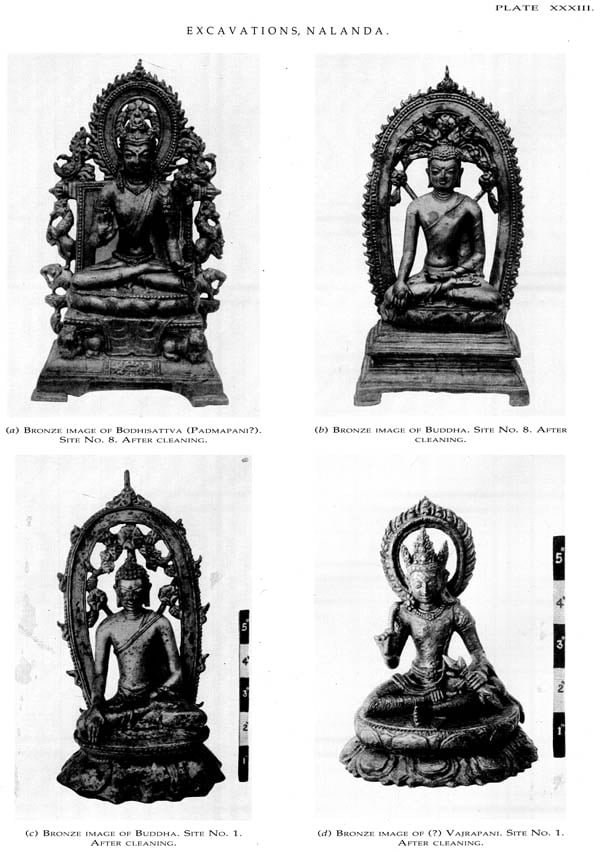
Annual Report of Archaeological Survey of India (1929-30)
Book Specification
| Item Code: | NAW450 |
| Author: | H. Hargreaves |
| Publisher: | ARCHAEOLOGICAL SURVEY OF INDIA |
| Language: | English |
| Edition: | 2002 |
| Pages: | 302 (50 b/w Illustrations) |
| Cover: | HARDCOVER |
| Other Details | 11.00 X 9.00 inch |
| Weight | 1.67 kg |
Book Description
The year under review witnessed considerable progress in all its varied spheres of activity. In connection with the conservation of central protected monuments in the United Provinces and Delhi, special mention may be made of repairs and improvements to a large number of monuments at Agra, the clearance of debris from the area between the so-called Mint and the Diwan-i-Am at Fathpur Sikri, the rebuilding of the Chabutra of the tomb of Bala Pir, which dates from the time of Aurangzeb at Kannauj, and the tomb and mosque of another Muhammadan saint dating from the 15th century in the same town; repairs to Rauza Kazmain at Lucknow; the Gupta temple at Deogarh; the Lakhesvara temple at Lakhamandal in the Dehra Dun district ; the brick temples of the late Gupta period at Bhitargaon and Parauli in the Cawnpore District ; preservation of the Shikargah built by Firoz Shah Tughlaq which now stands in the grounds of His Excellency the Commander in-Chief’s House at New Delhi; reconstruction of the Jali screens round the tomb of Ghaziu-d- Din Khan outside the Ajmeri Gate of Delhi; repairs to three out of the four gateways of the Arab Sarai, which is related to have been erected by Hamida Banu Begam, mother of Akbar; and further work at the multi-pillared hall, which must be indentified with the Thousand-pillared Hall of Muhammad-bin- Tughlaq in the city of Jahanpanah, one of the seven ancient cities of Delhi, etc. Among the numerous monuments that received attention in the Punjab, the Lahore Fort was again the principal centre of activity and the improvements effected during the year related to Jahangir’s quadrangle, the courtyard of the Diwan-i-Am and repairs to the Chhoti Khwabgah. the surrounding wall, etc.
In the Western Circle as many as 60 monuments received special repairs. These related for the most part to some of the Adilshahi monuments at Bijapur, the Monuments of the Ahmadshahi dynasty at Ahmedabad and those at Champaner at the last of which work was continued in accordance with a scheme approved several years ago. The Jogesvari Cave near Bombay, which is one of the largest known Brahmanical cave-temples and exhibits a striking resemblance both in design and sculptural decoration to the principal cave at Elephanta, had been in a very neglected condition. It has now been freed from débris and silt and a beginning has been made with the conservation of the rock-cut pulars that support the southern verandah. Other works of repair that deserve special mention were those carried out at Nalanda, Paharpur, Grooty in the Southern Presidency and Datia, where the palace a striking example of ancient palace architecture was inspected by Mr. Hargreaves with a view to its conservation.
In the field of exploration and research the reader will find an interesting account from the pen of Sir John Marshall of his excavations on the Sirkap site at Taxila. The explorer has now no doubt that the Parthian city on this site must have been destroyed by the Kushans shortly before 64 A. D., though he does not regard this date as absolutely certain. The structural remains of the Parthian city are found to be in a very dilapidated condition, but further digging is essential in view of the many deposits of jewellery, domestic utensils and other valuable objects of that period that have been brought to light. Two hoards of such valuable objects were found by Sir John Marshall in the year unde review. These were discovered in a room in block D and included an interest- ing relief representing wingless Kros and Psyche in gold repoussé, pendants, bangles, necklaces, girdles, etc., all of gold. Simultaneously with the surface excavations referred to above, Sir John Marshall continued deep digging in other pazts of the site and obtained from the stratification revealed valuable evidence as to the various dynasties that had occupied this site from the beginn- ing of the 3rd century B. C. The season’s excavations yielded 454 coins in all and descriptive lists of them showing the find-spot and the depth at which each coin was recovered are appended to the description of the operations. At Mohenjodaro Mr. E. J. H. Mackay was able to excavate a large area to an average depth of 16 to 18 feet below datum and exposed, besides numerous buildings, a large section over one-third of a mile in length of the main street of the area which in Sir John Marshall’s " Mohenjodaro and the Indus Civiliza- tion" is designated as Street I. Portable antiquities revealed by the excava- tion were numerous. Noteworthy among them are a razor with two edges, one straight and the other cvrved, which in general shape is similar to certain Egyptian examples; a sealing or amulet which bears on the reverse an incised design of a vulture with out stretched wings and human feet similar to the one found by myself at Harappa in 1924-25; an impression of a boss seal which depicts a buffalo surrounded by a number of dead bodies which are believed to represent a deity or a king surrounded by his dead enemies, and resembles some archaic examples from Mesopotamia ; an amulet the first of its kind go far found at Mohenjodaro, which shows certain resemblance to the Egyptian sign for stability; a medallion with a figure of the single-horned animal, so common on Mohenjodaro and Harappa seals, which was inlaid with coloured paste or other substance, and may have been a ritual ornament; and lastly a seal impression representing a buffalo about to be transfixed with a spear by a man. At Harappa Mr. Vat's excavations during the year brought to light a prehistoric cemetery on the low lying ground to the north of the local Museum on the site. Here besides a number of what appear to be complete burials in open ground, 110 burial jars were recovered. The contents of these jars have not yet been examined but the results are likely to prove of great value to the anthropologist.
That the Indus Valley culture was not confined to that region alone is proved by the discovery of a small site of that period at a village called Kotla Nihang in the district of Ambala. Some trial excavations carried out on this site revealed bricks and portable antiquities identical in shape and purpose to those found at Harappa and Mohenjodaro. One or two other sites in Sind were known to belong to the same early culture but very little was known of other sites in the Indus Valley itself. A regular survey of such sites in this province was extremely desirable and Mr. N. G. Majumdar was entrusted with the task. His tour extended over 2,000 miles from the delta of the River Indus north- ward as far as the Sukkur district. In the course of this journey over one hundred mounds and old sites were surveyed and out of these at least three definitely belong to the chalcholithic period. At Amri Mr. N. G. Majumdar discovered potteries of the Mohenjodaro period and an earlier type of thin paint- ed ware resembling potteries from Baluchistan and Seistan.
At Nalanda the excavation of Monastery site No. 8 was taken in hand and the portable antiquities recovered included a beautiful statue of Avalokitesvara and six bronze statues of Buddhas and Bodhi sattvas which must have been manufactured at Nalanda itself. At Paharpur, in addition to the excavation of some 120 cells of the monastery around the great temple, the central chamber of the latter underwent a thorough examination. A well constructed floor was found in this chamber at a depth of 38 feet from the top of the walls, but revealed no relics of any kind which would have enabled the determination of the purpose of this interesting structure. That the whole of this temple was constructed in the 6th or 7th century A. D. was, however, evident from the fact that a shaft sunk through this floor yielded no antiquities of an earlier date. At Nagarjunikonda Mr. Longhurst’s excavations brought to light two more stupas similar in plan to the Great Stupa built by the lady Chantisiri and described in the previous year’s report; two monasteries, a number of inscriptions and many bas-relief sculptures in the Amaravati style. Stupa No. 6 was opened and revealed the relics over which the structure had been erected. These were contained in a small gold reliquary which in its turn was placed in a stupa- shaped silver casket which was found in a very broken condition. The relics included, besides small gold lotus flowers and beads, a tiny piece of bone and two small medallions embossed with portraits of a king and a queen whose identity remains a mystery. The other stupa contained no relics but yielded well preserved and beautifully carved stone images.
The paintings on silk and other antiquities from Central Asia have now been exhibited along with prehistoric potteries in the Central Asian Antiquities Museum, and at Sarnath the whole collection of sculptures has been rearranged in chronological sequence, all ill-preserved or otherwise inferior specimens being relegated to a go down outside the exhibition galleries.
The Epigraphical Section of the Report deals with important inscriptions from Nagarjunikonda, Mathura, etc., while ‘Section IV, Museums" deals with important acquisitions made for the Indian and other Museums.
**Contents and Sample Pages**
